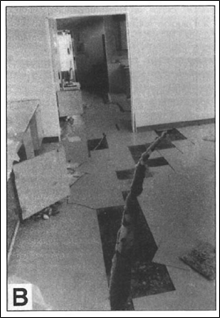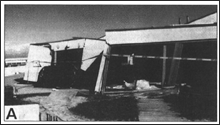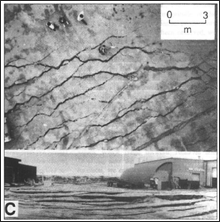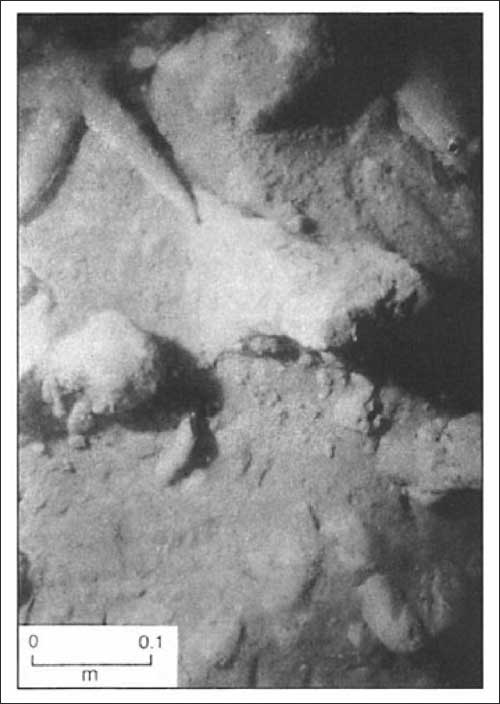
FACTS
- On October 17, 1989, a large earthquake occurred on the San Andreas Fault, causing extensive damage within 110 km of the epicenter in the Santa Cruz Mountains.
- The Moss Landing Marine Laboratories were destroyed because the unconsolidated sediments that comprise the Moss Landing spit underwent liquefaction, a quicksand-like behavior of soil.
- As much as 1.3 m of lateral movement was documented on the spit, as well as 0.65 m of subsidence. This subsidence equates to a rapid rise in local sea level, causing coastal erosion rates to increase for several years after the earthquake.
- Rapid response by regional researchers showed many offshore impacts of the earthquake, including large scarps and slumps. Many of these features were destroyed by erosion shortly thereafter.
Californians are well-educated about the effects of earthquakes on cities and infrastructure because the San Andreas Fault zone runs through most of the state. Yet there are many other impacts from earthquakes that occur in more rural areas and even under water. Researchers working at Moss Landing Marine Laboratories (MLML) documented both on-land and submarine effects of the 1989 Loma Prieta Earthquake, providing a more holistic picture of the power of these earth movements (Greene and others, 1991; see reference below).

The San Andreas Fault, which is actually composed of a complicated series of smaller faults, is over 1,280 kilometers (km) long and extends 16 km into the earth. The fault occurs where the Pacific and North American tectonic plates grind past one another; the former heading northwest and the latter moving southeast. While the plates are moving laterally, they are also pushing into each other slightly. This complex fault motion results in earthquakes when friction, which has built up between the plates over time, is suddenly released. Ground motion is the most obvious impact of earthquakes, but other, more permanent effects, such as landslides and liquefaction (quicksand-like behavior of soil), take place regularly.

At roughly 5:00 pm on October 17, 1989, a magnitude 7.1 earthquake occurred on the San Andreas Fault, centered near Loma Prieta in the Santa Cruz Mountains. Ground shaking was felt 50 km away in Moss Landing and the unconsolidated sediment of the Moss Landing spit began to jostle and act like quicksand. The result of this liquefaction was that water trapped between sediment grains was released, sediment migrated laterally, and the land subsided.
Researchers in their offices at MLML observed water spraying up from cracks that had developed in the courtyard. Mud volcanoes and sand boils up to 1 meter (m) high erupted on an adjacent volleyball court and continued to do so for as much as 45 minutes after the quake. Sediment that erupted on the volleyball court originated from layers 3.3-6.6 m and 10-15 m below the surface, according to consultant analyses.
Fortunately, flooding patterns seen during the March 12th, 1995 event can be used to develop new flood control and water retention areas that can best benefit groundwater, water quality, wildlife habitat, and infrastructure protection.
The Geology Lab of MLML developed an extensive crack through the floor (Figure 1) and the entire building was pulled apart (Figure 2). Sewer and water lines ruptured, the one-way bridge was closed because the east end sank 0.4 m, and surface cracks developed in pavement and soil (Figure 3). The tide following the quake was 0.3 meters higher than anticipated at the Monterey Bay Aquarium Research Institute (MBARI) pier, indicating that subsidence had occurred there. Combining these and other observations, the researchers documented land lowering of 0 to 0.65 m and up to 1.3 m of lateral stretching on the Moss Landing spit. This subsidence equates to a rapid rise in sea level, causing coastal erosion rates to increase dramatically for several years after the earthquake.
One of the most interesting on-land observations made in Moss Landing was that water quickly drained out of the harbor shortly after the Loma Prieta Earthquake. Two minutes later, a small (0.5 m) wave rushed back into the harbor, raising the water level. Researchers working in the area thought this small, tsunami-like wave might have occurred because of seafloor disturbance caused by the earthquake; between MBARI and MLML, researchers had the facilities to rapidly investigate the surrounding seafloor.
Side-scan sonar imaging of the shallow continental shelf just offshore of the spit showed evidence for liquefaction features oriented generally the same direction as those seen on land (Figure 4). In addition, they occurred at approximately the same depth range (9-12 m) as those found in the MLML volleyball court. West-facing scarps (3-6 m high and 100 m long) were noted, with hummocky slump surfaces and possible mud volcanoes or sand boils further offshore. Evidence of these shallow features was wiped out by erosion within 2 months of the earthquake.
Using a remotely operated vehicle with a camera, researchers documented fresh slump scarps on the south wall of the upper Monterey Canyon, which is composed of fine-grained deltaic deposits from the Salinas River. The largest of these scarps was 6.3 m high and was covered with starfish and worms that were feeding on the freshly-exposed benthic fauna (Figure 5). Pre- and post-earthquake surveys found that the upper channel of the canyon had been filled with up to 30 m of sediment, most likely from earthquake-generated landslides and slumps from the canyon walls. These same landslides may have been the trigger for the small tsunami-like wave that rushed through Moss Landing Harbor just after the earthquake.
There is evidence that the on-land and submarine impacts documented by the researchers in Moss Landing have occurred as the result of previous large earthquakes, such as the 1906 San Francisco quake, and will likely happen again during future events. Differences in building construction, as well as natural variation in the sedimentary geology of the spit, contributed to the variability of damage that took place in Moss Landing during the 1989 Loma Prieta earthquake. Planners can use this knowledge to build structures in safer locations with better materials to withstand liquefaction and ground shaking. In addition, other California coastal communities with similar geologic settings, such as San Diego, Morro Bay, Seal Beach, and Arcata, can learn lessons from the damage at Moss Landing.


Reference:
Greene, G. H., Gardner-Taggart, J., Ledbetter, M.T., Barminski, R., Chase, T.E., Hicks, K.R., and Baxter, C. (1991). “Offshore and onshore liquefaction at Moss Landing spit, central California – Result of the October 17, 1989, Loma Prieta earthquake.” Geology(19): 945-949.
Links to More Information
USGS information on the 1989 Loma Prieta Earthquake, including photographs
USGS information on the San Andreas Fault